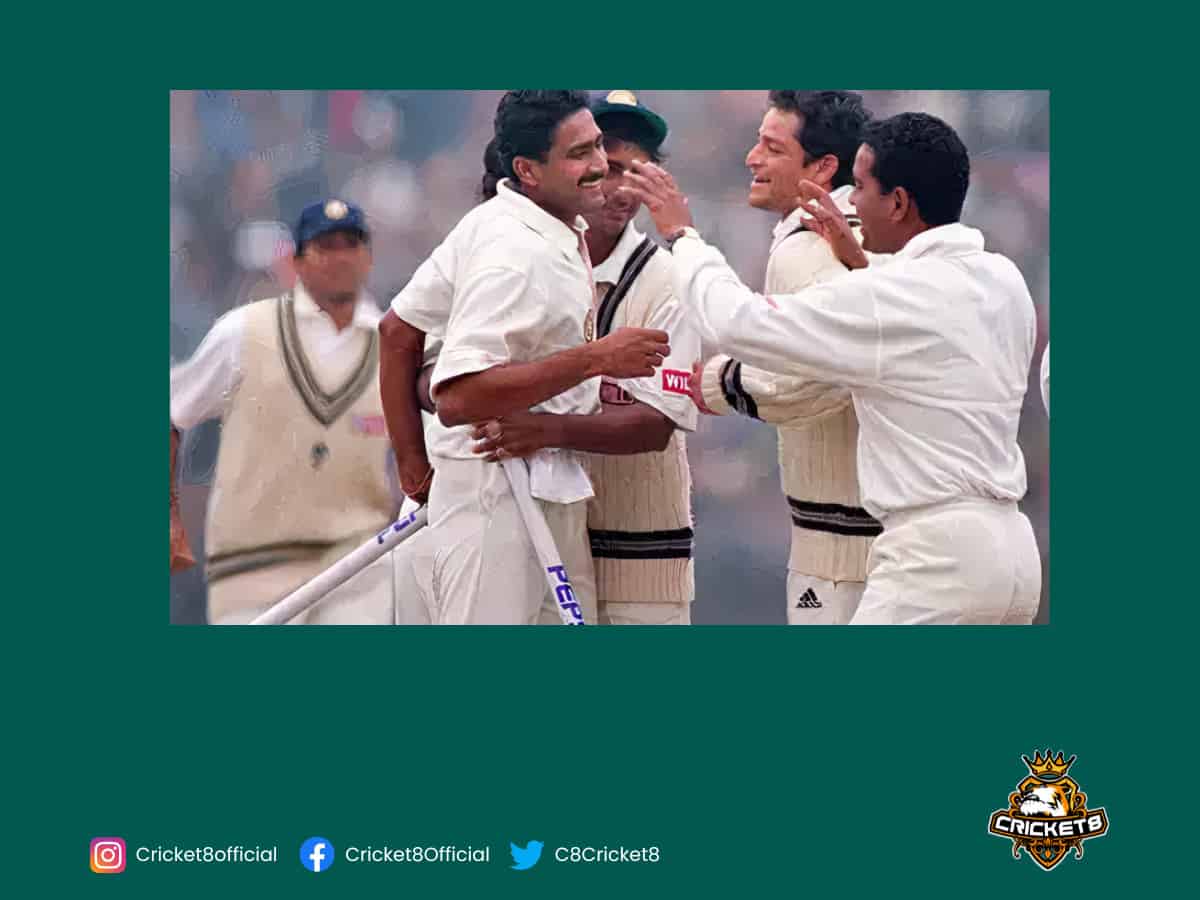On a memorable day, February 7, 1999, Indian cricket witnessed a historic moment that etched the name of Anil Kumble into the annals of immortality. The legendary spin bowler achieved the remarkable feat of capturing all ten wickets in the second innings of a Test match against Pakistan at the iconic Feroz Shah Kotla Stadium in New Delhi. This extraordinary achievement made Kumble the first Indian and only the second cricketer in history to accomplish such a feat.
Setting the Stage
The second Test of the series between India and Pakistan in 1999 was poised for an intense battle. After low first innings scores on a dusty Feroz Shah Kotla wicket, India had gained an advantage on the third day with a brilliant performance from Sadagoppan Ramesh, who followed up his first innings score of 60 with a boundary-studded 96. As the innings concluded on the fourth morning at 339, India set a target of 420 for Pakistan to chase.
Anwar and Afridi’s Resilience
The Pakistani opening pair of Saeed Anwar and Shahid Afridi defied the Indian bowlers with a display of flamboyant confidence. The pitch, despite being suspect and substandard due to vandalism by fundamentalists, seemed to have lost its venom. Anwar and Afridi’s aggressive batting raised hopes of an improbable victory for Pakistan. At lunch, Kumble’s figures were not too flattering, none for 27 from 6 overs, as he mostly bowled from the Football Stand End.
Kumble’s Magical Spell Begins
During the break, Mohammad Azharuddin, convinced of Kumble’s ability to make an impression on the pitch, urged him to switch to the Pavilion End. This decision proved to be a turning point. In his third over of the new spell, Kumble enticed Afridi to flirt with a delivery outside the off stump. There was a distinct noise, and both Kumble and wicketkeeper Nayan Mongia leaped up in appeal. Umpire AV Jayaprakash raised his finger, and Afridi walked back, visibly disgusted.
The Fall of Wickets
With Afridi’s dismissal, Kumble realized that he had a chance to create history. Ijaz Ahmed, the next batsman, fell victim to Kumble’s favored tactic against new batsmen. The delivery struck Ahmed’s pads on the full, leading to a clear LBW decision. Inzamam-ul-Haq managed to survive the hat-trick, but not for long. Playing tentatively at a short of good length delivery, he ended up playing on to his stumps. Pakistan were 3 down for 115, and Kumble’s momentum was building.
Kumble’s Five-Wicket Haul
Kumble continued to make inroads into the Pakistani batting line-up. Mohammad Yousuf, then known as Yousuf Youhana, played down the wrong line and was trapped plumb in front of the wicket. Moin Khan, a proficient player of spin, was promoted up the order but also succumbed to Kumble’s skill. Pushing forward, Khan got an edge that looped to slip, and India had taken five wickets with Pakistan’s score at 127.
Anwar’s Resistance and Kumble’s Determination
Saeed Anwar had been batting beautifully and seemed to negotiate Kumble’s deliveries with ease. However, Kumble changed his angle of attack, coming back over the wicket to the left-hander. He floated a slow leg-break that kissed Anwar’s bat, hit the front pad, and lobbed to VVS Laxman at short-leg. Anwar departed for 69, and it was at this moment that Kumble realized the possibility of capturing all ten wickets.
Kumble’s Historic Moment
For nearly an hour, Saleem Malik and Wasim Akram held fort for Pakistan. Sensing the need for a breakthrough, Kumble returned refreshed after tea. Malik, injured and restricted in movement, fell victim to Kumble’s guile. The ball was pitched short, and Malik, attempting to pull, mistimed the shot, resulting in the ball hitting the top of the stumps. The very next ball, Kumble fired a delivery straight at Saqlain Mushtaq’s pads, trapping him in front. Pakistan were 9 down for 198, and Kumble was on the brink of history.
Javagal Srinath’s Role
Javagal Srinath played a crucial role by providing Kumble the opportunity to capture all ten wickets. Initially, Kumble’s plan was to allow a single to Akram and attack Waqar Younis. However, when Akram refused to take singles, Kumble bowled a normal leg-break. Akram played at it, and the inside edge flew fast to short leg, where Laxman made a brilliant catch. With Akram’s dismissal, India emerged victorious by 212 runs, and Kumble’s name was etched in the record books alongside Jim Laker, the only other cricketer to achieve the feat.
Celebrations and Legacy
As Kumble took his final wicket, the crowd at the Kotla erupted in unconfined joy, dancing and chanting his name. The Indian team carried him off the field in their arms, while fans clamored to touch their hero, even tearing his shirt in the process. Kumble’s magnificent achievement was a testament to his skill, determination, and unwavering spirit.
Kumble’s Unique Place in History
Anil Kumble’s 10-wicket haul against Pakistan on February 7, 1999, will forever be remembered as a defining moment in Indian cricket. His extraordinary feat, achieved with unwavering focus and skill, placed him in an elite group of cricketers who have achieved this rare milestone. Kumble’s relentless pursuit of victory and his unwavering commitment to the sport have cemented his legacy as one of India’s greatest cricketing heroes.
Conclusion
Anil Kumble’s historic 10-wicket haul against Pakistan in 1999 stands as a testament to his unwavering skill, determination, and dedication to the game. His remarkable achievement, capturing all ten wickets in a single innings, placed him in an exclusive club of cricketers and solidified his legacy as one of India’s greatest spin bowlers. The memories of that magical day at Feroz Shah Kotla Stadium will forever be etched in the hearts of cricket fans worldwide, serving as a reminder of the extraordinary feats that can be achieved through sheer talent and perseverance.



